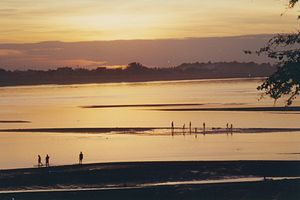Last week, Laos’ newly elected president visited Vietnam in a bid to boost ties following leadership transitions in the two communist neighbors.
Bounnhang Vorachith, who clinched the post of Laos’ Communist Party chief back in January before being appointed president on April 20 by the National Assembly, made his official visit to Vietnam, which had also just finished going through its quinquennial Party Congress. The visit, which was his first overseas trip, lasted from April 25 to 27 and saw him meet with several top Vietnamese officials in Hanoi, including General Secretary of the Communist Party of Vietnam Nguyen Phu Trong, President Tran Dai Quang, Prime Minister Nguyen Xuan Phuc, and Vietnam’s first ever chairwoman of the National Assembly Nguyen Thi Kim Ngan. The Lao president then wrapped up his trip with a visit to Ho Chi Minh city.
Both sides discussed the state of the bilateral relationship, vowing to boost economic ties by expediting Vietnamese investment projects into Laos and improve collaboration with Lao localities. Vietnam is one of Laos’ top trading partners and investors, and both sides signed a key border trade agreement last year designed to help improve ties.
But Vietnam and Laos also discussed subregional and regional issues as well, including the Mekong River – one of the world’s longest rivers, which flows from the Tibetan Plateau through China and mainland Southeast Asia – and the South China Sea disputes. On the Mekong, Quang, the Vietnamese president, thanked Laos for releasing water in late March from its dams to the Mekong to help Vietnam’s southern region cope with severe drought and saltwater intrusion. Due to the effects of El Nino, rainfall in the region had plummeted by up to 30 percent, causing the amount of water flowing from the Mekong to Vietnam to fall by half. According to Vietnam’s foreign ministry, Laos had said that it will continue to release water until the end of May.
Quang also urged Laos to continue to cooperate with other riparian nations for sustainable management of water resources in the Mekong River. Laos’ plan to build a string of dams to fuel its economic development has triggered concerns among its neighbors about how it could affect the river, which provides food, water, and transportation to tens of millions of people. Vietnam’s Mekong Delta alone is home to 20 million people and accounts for more than half of its rice and fruit production (See: “Mekong Under Very High Threat: Vietnam”).
Unsurprisingly, the South China Sea was also discussed by both sides, with Vietnam, a claimant in the disputes, making its position on the issue clear. With Laos, a non-claimant and close Chinese partner, being this year’s chair of the Association of Southeast Asian Nations (ASEAN), there have been concerns about how the South China Sea issue will be managed in ASEAN forums. Just last week, Xinhua reported that China’s foreign minister, Wang Yi, had forged a “four-point consensus” on the issue during separate visits to Brunei, Cambodia and Laos, causing worries about Beijing trying to divide ASEAN ahead of a verdict on the Philippines’ South China Sea case expected in May or June (See: “What’s Behind China’s New South China Sea Consensus With Three ASEAN States?”).
Both sides also agreed to maintain peace, stability, security, and safety in the South China Sea and ensure that disputes are settled by peaceful means and in line with international law. Vietnam also said that it was actively willing to support and share its experience with Laos to help it fulfill its role as ASEAN chair this year.

































